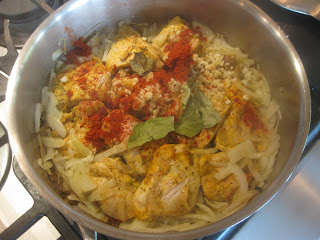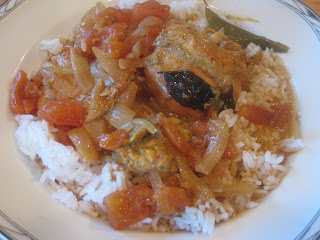This is the second time I've made this (I forgot to take pictures last time!), and it was just as good as we remembered...tender chicken thighs, a flavourful sauce, reminiscent of a mild curry, but with the citrusy tang of limes and tamarind. Served on a bed of basmati rice, it hit the spot.
This time I used the last tablespoon of tamarind concentrate, the last lime, the coconut milk from the freezer, 3 soft tomatoes and some of the dried curry leaves that I haven't used very often and am still experimenting with.
Marinade 6 chicken thighs in:
Zest and juice of 1 lime
1/2 teaspoon ground black pepper
1/2 teaspoon turmeric
Cover and refrigerate for about an hour. I used this time to prepare everything else needed for the sauce.
In a heavy bottomed pan, over medium heat, with a bit of olive oil, cook:
1 medium onion, sliced
Cook until the onion softens and starts to caramelize. Do not allow it to get too much colour.
Add the marinated chicken thighs and cook until they are seared on all sides, keeping the heat medium.
Now add the spices:
4 cloves garlic, minced
1 teaspoon fresh ginger, minced
6 dried curry leaves
1 teaspoon paprika
Cook for a few minutes, stirring to make sure that the chicken and onions are well coated with the spices.
Add in:
1 pound of fresh tomatoes, peeled, seeded and chopped...this was 3 tomatoes.
Cook, stirring to combine, and allow it to simmer for 5 minutes.
Measure out:
1 cup chicken stock
Whisk in:
1 tablespoon tamarind concentrate
1 tablespoon sugar
Add this mixture to the pot and simmer for another 5 minutes.
Lastly, stir in:
1 cup coconut milk
Cover and simmer for 45 minutes, or until chicken is very tender.
Serve over warm rice, dividing the chicken and sauce evenly.
- I used skinless, boneless chicken thighs, and cut each one in half to give smaller pieces that are easier to eat. Cubed chicken breast could also be used, as could pork or beef. The cooking time would need to be increased for tougher cuts of meat, to allow them enough time to become tender.
- If you are having trouble finding tamarind concentrate or paste in your grocery store, try an ethnic store, it is used in Asian cuisine a lot. You can add more lime juice if you like, but might find that the amount of sugar needs increasing. Adding a couple of dates along with the lime juice will offset the acid by adding sweetness; it will also add the pulpy effect and brown colour of tamarind.
- To peel the tomatoes, cut out the stem and score an 'X' in the skin on the opposite side of the tomato. Place into boiling water for 30 seconds to a minute - you will see the skin starting to lift away from the cut areas. Immediately place under cold running water to stop the cooking process; this also helps to lift the skin. Gently peel the skin off, cut the tomato in half and remove the seeds.
- Canned tomatoes can be substituted.
- Curry leaves have a very mild aroma and taste that is quite unique. They can be omitted if you are unable to find them. Look in higher end grocery or specialty food stores, ethnic stores or online. They can be purchased fresh or frozen; if you buy them fresh store the extras in the freezer. They can also be bought dried, which is what I have...someone gave them to me. Dried curry leaves have a less intense flavour. They can be eaten as they soften up more than bayleaves do during cooking.
- Feel free to add more vegetables if you like, or to omit the meat and use only vegetables.
- To peel fresh ginger easily without removing too much of the flesh, use a spoon and scrape a thin layer of the skin off. I like to use the finest side on the box grater to mince the ginger. This also releases a lot of the juice, so often less ginger can be used, as the flavour is more intense. You are also less likely to end up with larger chunks of ginger, important when some members of the family are not big ginger fans.









No comments:
Post a Comment